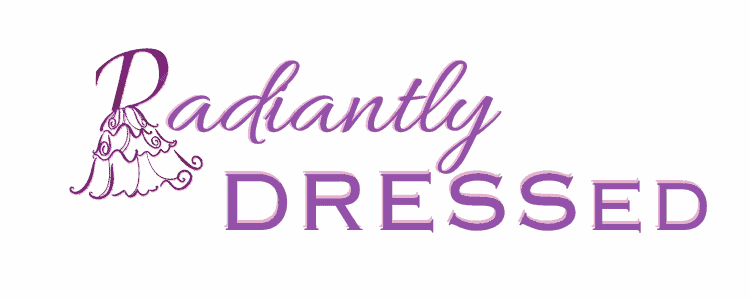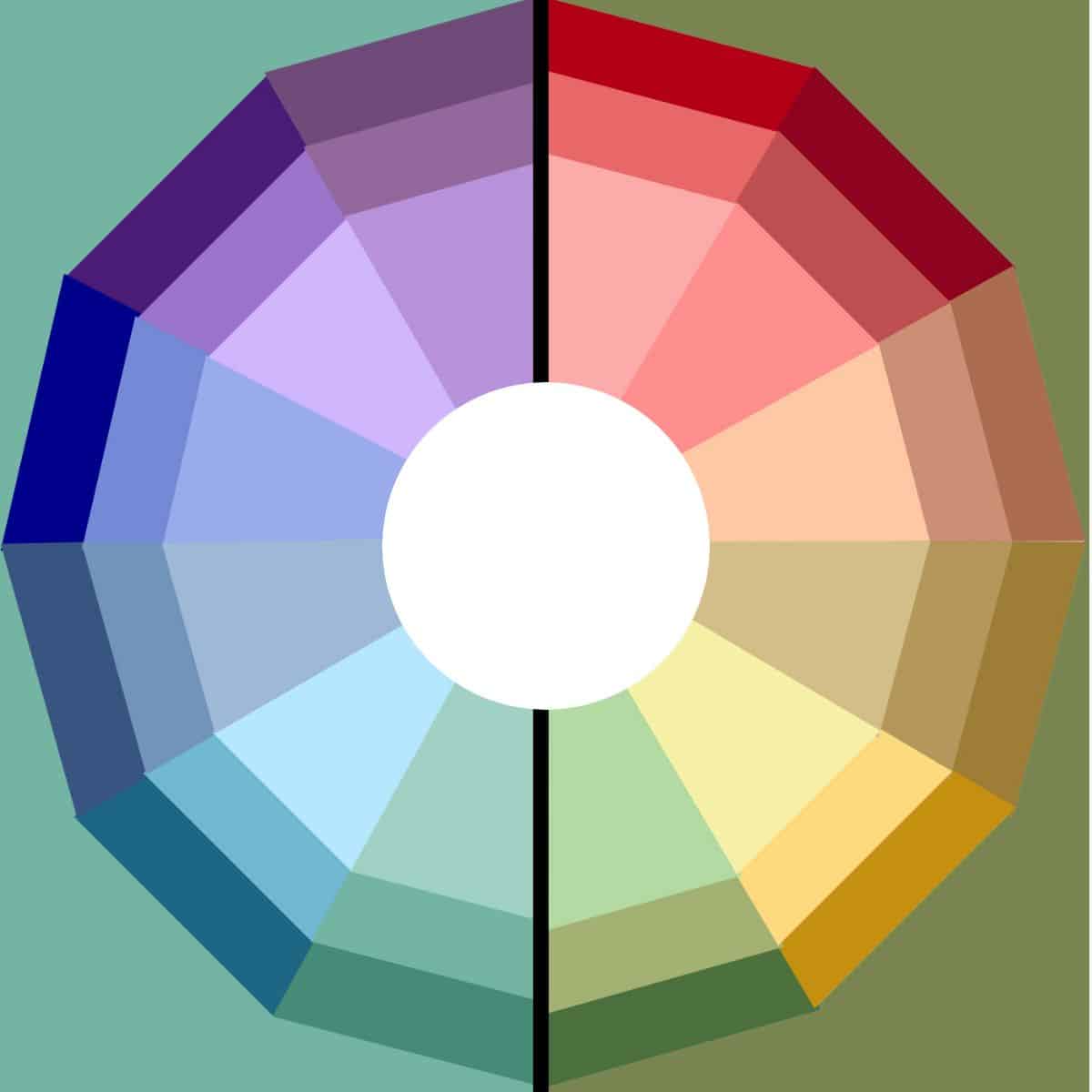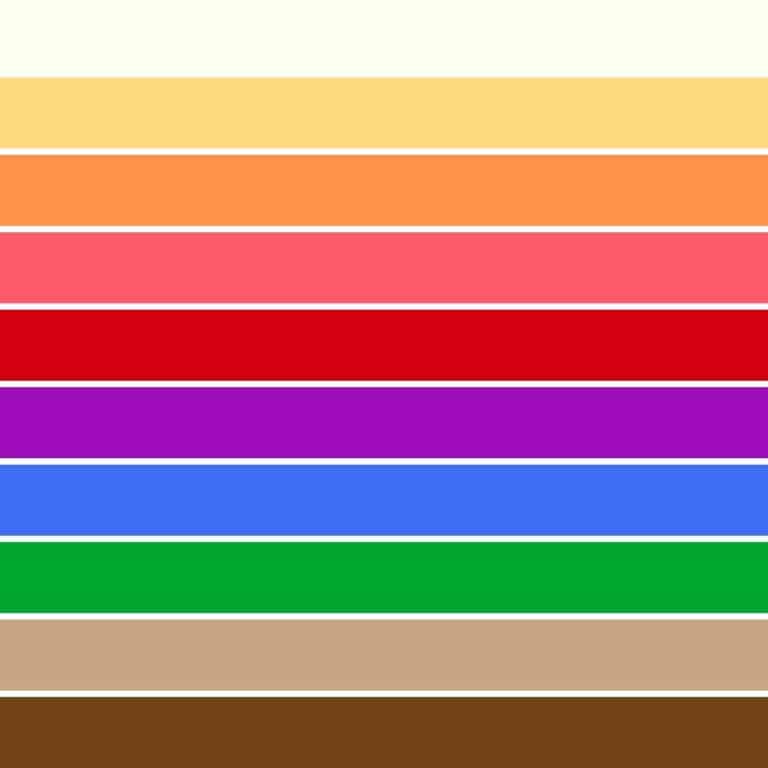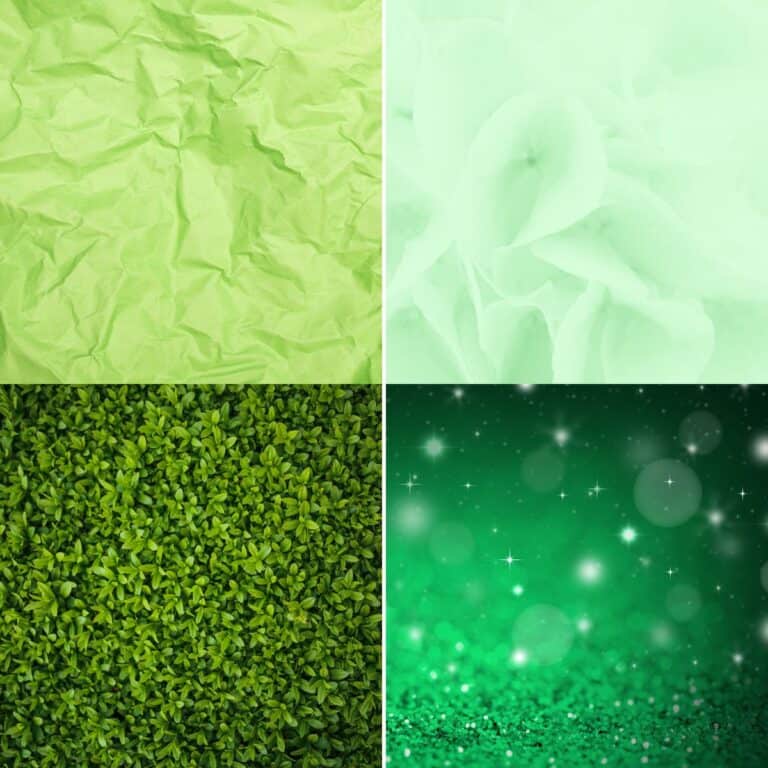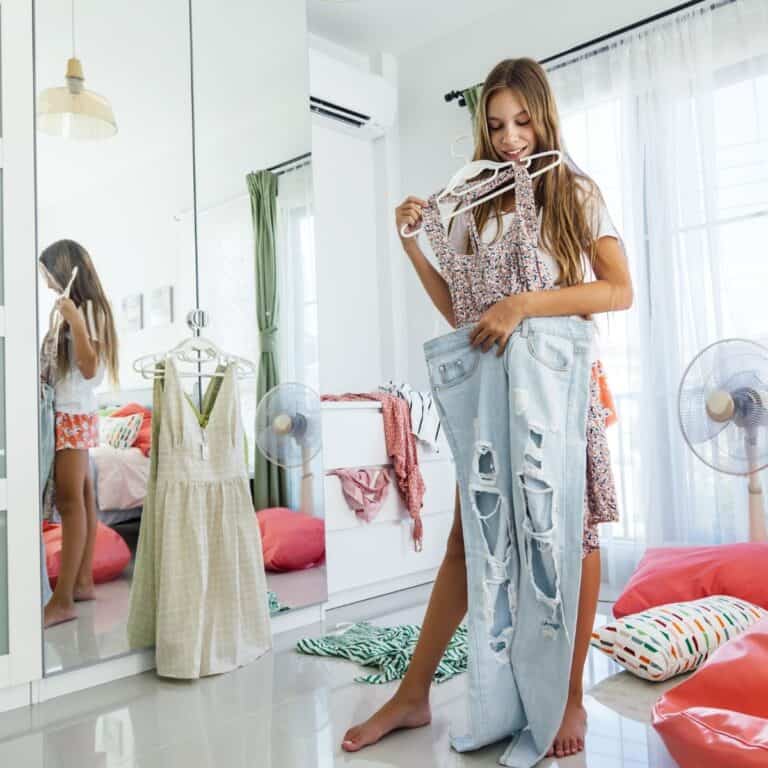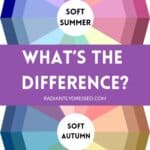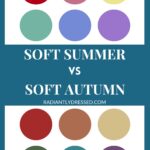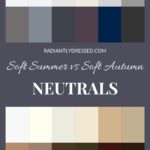Understanding the difference between Soft Summer and Soft Autumn is essential for anyone looking to refine their wardrobe choices, ensuring that every color selected enhances their personal style.
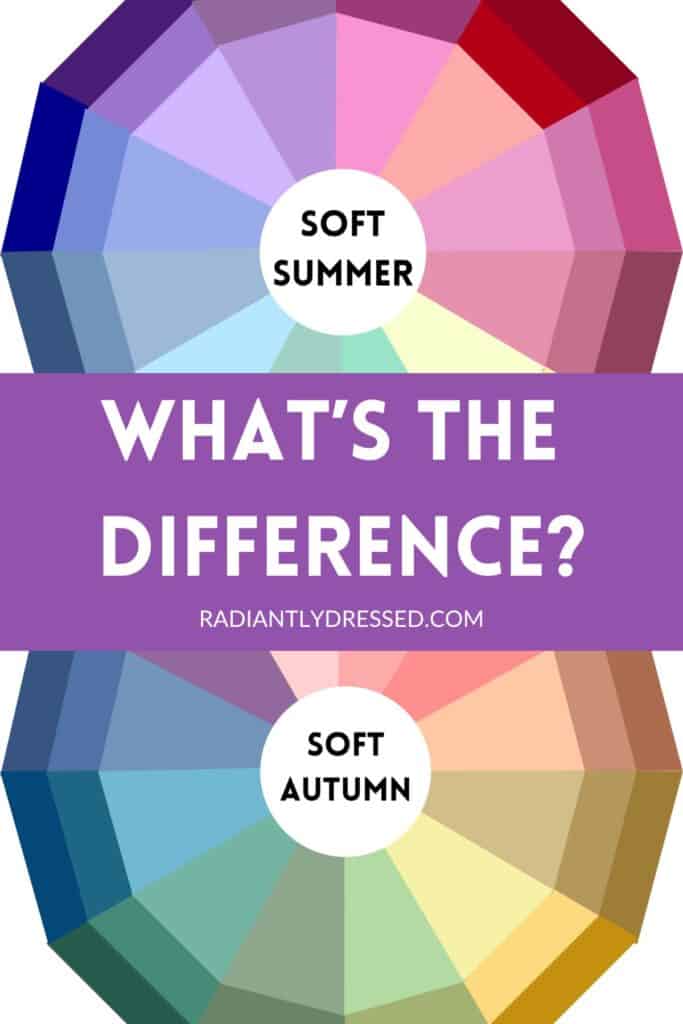
This is the second installment in our ongoing comparison of neutral seasons that share primary tonal attributes. We’re going to be looking at soft autumn and soft summer today, and four different ways that you can try to tell the difference between these two seasons if you’re stuck and really unsure.
Understanding the nuances between Soft Summer and Soft Autumn color seasons will enhance your ability to choose clothing and makeup that complement your natural coloring. Color analysis is a systematic approach to identifying the colors that resonate best with your skin tone, hair, and eye color. Once you determine your color season, you’ll be able to create a wardrobe that highlights your features, giving you a harmonious and vibrant look.
Soft Summer and Soft Autumn are part of the 12-season color analysis system, representing two color palettes that bridge the gap between the cooler summer and the warmer autumn seasons. If your overall appearance is muted with a cool or neutral undertone, you might find yourself gravitating towards the Soft Summer palette. In contrast, if your features have a hint of warmth with a muted quality, Soft Autumn colors may be more flattering for you.
This distinction is not as common a problem as deep autumn and deep winter, which we discussed last week. However, when we examine the distribution of people within these seasons in North America specifically, deep autumn and deep winter typically emerge as the most common, followed by soft autumn and soft summer.
This indicates that in tonal color analysis, deep is the most prevalent attribute, with soft being the second most common. Therefore, it’s a high likelihood that many individuals fall into one of these two seasons, and you may be struggling to determine which one you are.
Table of Contents
Understanding Color Seasons
When you dive into the concept of color seasons, you’re navigating a framework created to assist you in discovering the colors that most enhance your natural beauty.
Soft Summer and Soft Autumn are two of the twelve color seasons that form part of a Seasonal Color Analysis. This analysis assesses your skin tone, eye, and hair color to categorize you into a specific season. Each season is linked to a set of colors that harmonize with your natural coloration.
Soft Summer characteristics include:
- Undertones: Cool to Neutral-Cool
- Hue: Primarily cool hues with some neutral
- Best Colors: Medium to dark, muted and soft
Soft Autumn traits are:
- Undertones: Neutral to Warm
- Hue: Brown based muted colors
- Best Colors: Medium-to-dark with low contrast
By understanding your color season, you can enhance your wardrobe and makeup choices, ensuring that they flatter your natural coloring. Remember, the best hues for you are those that reflect your inherent tones, creating a harmonious and balanced look.
Characteristics of Soft Summer
Soft Summer is distinguished by its cool and muted color palette, with hues that blend seamlessly into a low-contrast look that’s often described as gentle and subdued.
Color Palette of Soft Summer
Your Soft Summer color palette is characterized by cool, gentle shades that evoke a sense of tranquility and understated elegance. You should look for colors that blend cool blue undertones with a subtle grayish tint. Here’s how your Soft Summer colors break down:
- Neutrals: You’ll find a range of grays from light to charcoal, navy, and soft white in your neutrals. Black should generally be avoided as it can be too harsh against your soft coloring.
- Soft Hues: Embrace soft blues, pinks, and lavenders, all with that distinctive cool undertone.
- Darker Tones: For depth, you can rely on muted and smoky versions of marine blue, forest green, and plum.
- Fabrics: Look for materials that have a bit of a muted sheen rather than high-sheen fabrics; think matte silks or cotton with a soft finish.
Remember, shiny or bright fabrics can overpower your color characteristics, so opt for textures that complement the softness of your palette.
Characteristics of Soft Autumn
In understanding Soft Autumn, your focus is on a color palette that perfectly blends the warmth of autumn with the subtle softness of summer.
Color Palette of Soft Autumn
Your Soft Autumn color palette contains hues that are rich yet muted, reflecting the natural warmth and depth typical of the season. The colors aren’t bright or crisp but rather have a soft, subdued quality. Here’s a fundamental guide to your Soft Autumn palette:
- Neutrals: Expect to find versatile neutrals ranging from warm greige (a mix of gray and beige) to creamier shades like taupe and off-white.
- Colors: Your unique palette will include warm earth tones like olive greens, medium teal, and brown with red undertones. You will also find warm peach, coral, and dusty pinks.
- Metallics and Accents: Gold tones serve as ideal metallics, providing a gentle shimmer that complements this muted palette.
Remember, the Soft Autumn palette stays clear of saturated jewel tones and icy colors and opts for softness and warmth with a touch of sophistication.
How to Distinguish Soft Summer vs Soft Autumn
These seasons, soft autumn and soft summer, are notably more complex than deep winter and deep autumn because they share numerous similar attributes and display a significant variety in their value.
As a brief refresher in color analysis, we consider three main attributes: hue, value, and chroma. Hue determines if you’re warm, cool, or muted; value assesses how light or dark your features are, influencing the colors that suit you; and chroma measures your saturation level or mutedness. Notably, soft seasons are the most muted within the 12-season spectrum, lacking any significant brightness, which means if you notice brightness in your appearance, a soft season might not be your match.
These seasons also possess similar value characteristics, showing a wide range—some individuals may appear light, others dark, indicating a lack of a strict standard. Regarding hue, soft autumn leans towards warm neutral, whereas soft summer aligns with cool neutral. With this overview of their general attributes, we explore four distinct methods to help determine which season aligns with you.
Warm or Cool Undertone
Let’s start where we always do, and where we began last week as well. Let’s check the undertones. Avoid looking at your veins or the makeup color you wear. Instead, focus on one simple test: pinch your finger as if you were preparing to give blood. You’ll notice the end of your finger turns a shade of red, which I describe broadly. You’ll observe one of two shades: a purplish-pink indicating cool undertones or a coral or orange hue suggesting warm undertones.
This test is highly accurate for discerning cool or warm undertones. It’s a method I consistently rely on for client analyses, serving as a gold standard to guide the overall outcome. Thus, it can clearly indicate whether you lean towards warm or cool, pointing you towards soft summer for cool undertones or soft autumn for warm.
If you struggle to determine your undertones, seeking a second opinion from a friend or spouse can be beneficial. Their perspective might offer the clarity needed to distinguish between a pinkish-purple or orange-coral shade.
Value Variations
The next aspect to discuss is the value variations between these two seasons. Traditionally, soft summer was considered to range from light to medium in value, while soft autumn was categorized as medium to dark. This categorization has been the conventional standard. However, it’s quite common for soft summers to exhibit more value than anticipated, often falling into the medium to medium-dark range rather than just light to medium.
Regarding soft autumns, there tends to be a propensity towards lighter shades, particularly within certain colors of their palette. For reds, oranges, pinks, and yellows, lighter versions are preferable. Conversely, for greens, blues, and purples, darker shades are more suitable. Soft summers, known for their depth and richness in color, typically require these darker shades across their entire palette. This contrast in value can sometimes lead soft summers to question if they might actually align more with deep winter, adding an element of confusion.
On the topic of value, consider whether you gravitate towards light, dark, or medium colors. It’s common for many to find that medium colors suit them best, which is typical for both soft autumns and soft summers. It’s important to be aware of the specific colors and the depth that best complement your palette.
Moving on, the next test will clarify this further, especially when we delve into neutrals.
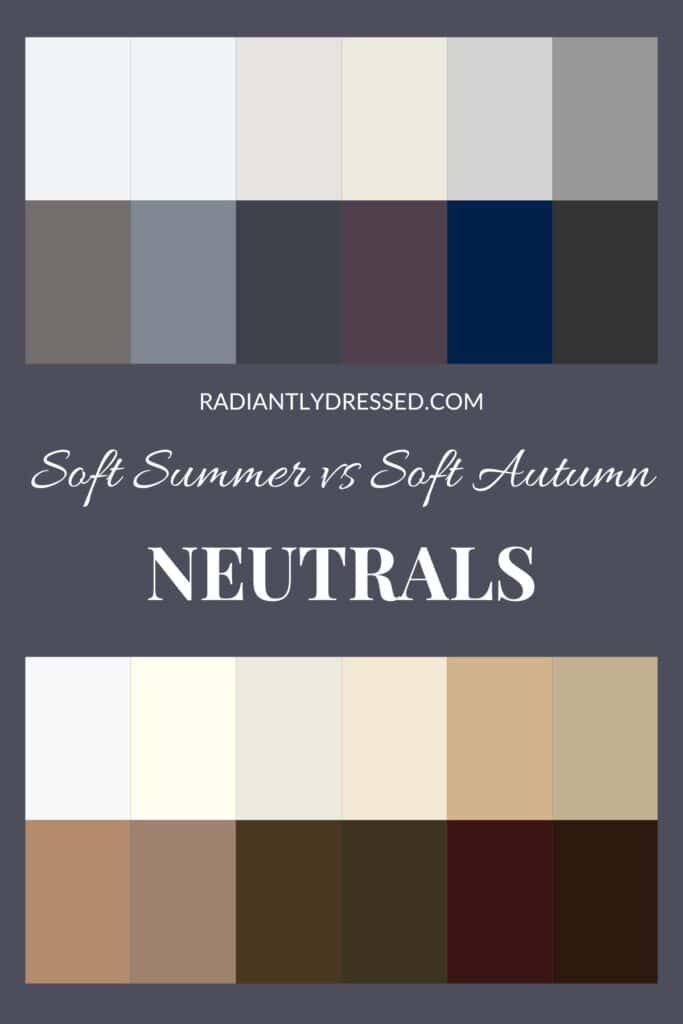
Soft Season Neutrals
Let’s delve into the topic of neutrals. As muted seasons, both soft autumn and soft summer favor neutrals that are subdued compared to their overall color schemes. While black and white are classic neutrals, they typically don’t feature in these palettes. Instead, we see a preference for navy, browns, grays, and off-whites.
For soft autumn, warmer neutrals like browns and creamy off-whites are essential. However, these browns are not overly saturated or vivid—think more along the lines of toned-down camels or gray-browns, rather than vibrant cognac shades. Their off-whites lean towards ivory or cream, avoiding any bold or dark tones. Soft autumns find harmony in these subdued browns and can confidently wear popular tan shades, which complement their palette beautifully.
Conversely, soft summer steers clear of browns, rarely incorporating them into their wardrobe. On the occasion a soft summer selects a brown, it’s likely to be taupe—a color that’s not purely brown. Soft summer’s neutrals include navy, which, while pure navy works, a slightly softened version enhances their look even further. Their version of off-white is a gentle soft white, possibly with blue undertones to highlight their coolness. Grays for soft summer should have a blue base, distinguishing them from the browns-based grays that don’t align with their cool-toned nature.
Sage versus Army Green
The final aspect to consider in determining whether you’re a soft summer or soft autumn involves the color green. Greens in these seasons are subtly muted, with olive and sage showcasing the distinction. Olive green, with its yellow undertone, suits soft autumn, while sage green, with a gray-blue undertone, complements soft summer. However, discerning these subtleties can be challenging without a trained eye.
To clarify, conduct a test with army green, a color slightly darker and warmer than olive, embodying more depth. Drape an army green fabric around your face and observe the effect. If your complexion appears healthy, without inducing a sallow or ill appearance, it suggests warm undertones favorable to soft autumn. Conversely, if this deeper green accentuates flaws or makes you appear unwell, indicating a discord with your natural coloring, you’re likely better suited to soft summer.
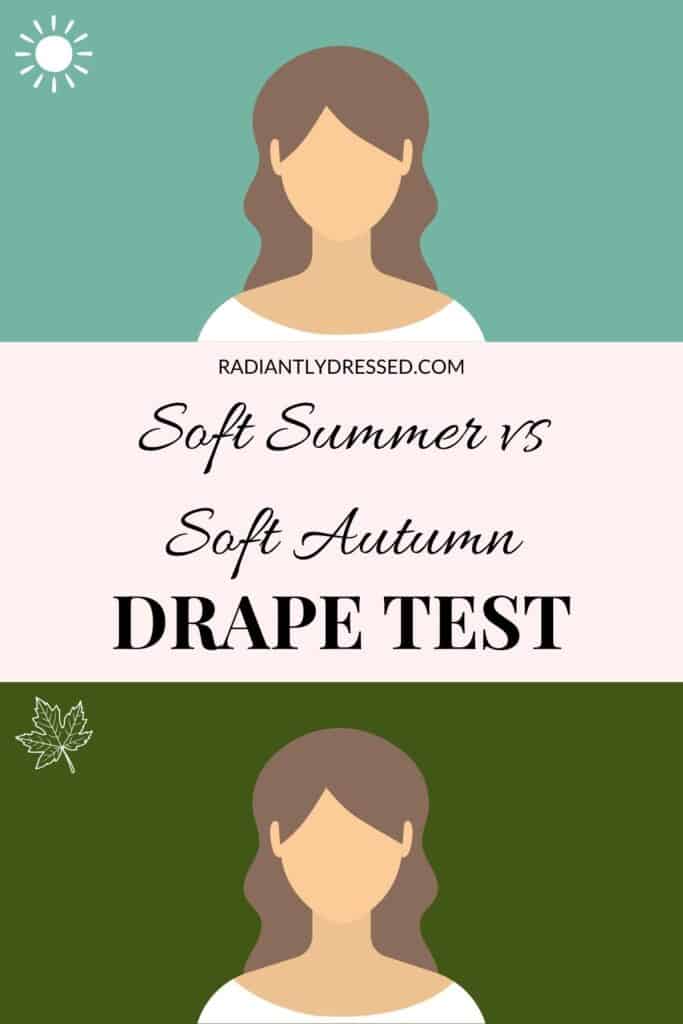
Determining Your Color Season
Venturing into the realm of color analysis is not merely about fashion; it’s a strategic approach to aligning your clothing and cosmetic selections with the innate hues of your hair, eyes, and skin. Distinguishing between Soft Autumn and Soft Summer is vital, as each season has its distinct spectrum of colors that can enhance or undermine your natural allure.
DIY Color Analysis
For those keen on exploring their color season from the comfort of their home, my DIY Color Analysis Course is the perfect starting point. This course empowers you with the knowledge to understand the nuances of color theory to find your best colors.
Transitioning to Professional Color Analysis
While the DIY course provides a solid foundation, transitioning to a professional color analysis can further refine your understanding of your color season.
A professional analysis offers:
- Expert Guidance: Benefit from an experienced eye that can discern subtleties in your coloring, leading to a more nuanced understanding of your season.
- Customized Palette Recommendations: Receive a personalized palette that includes detailed recommendations for clothing and makeup, ensuring every choice you make is in harmony with your natural beauty.
While there is a cost associated with professional color analysis, the investment is in yourself—yielding a individualized assessment that enhances your style, confidence, and the way you present yourself to the world.
Whether you start with DIY analysis or dive straight into professional consultation, understanding your color season—Deep Autumn or Deep Winter—is a transformative step towards embracing your authentic self and showcasing your inherent beauty with every outfit and makeup choice.
Tired of going round in circles trying to figure out your color season? Hack the same process used by professional color analysts to figure out your season from the comfort of your home, and stop feeling confused about color analysis with Personal Prism.
FAQ
What are the defining characteristics that differentiate a Soft Summer from a Soft Autumn color palette?
Soft Summer features cool undertones with a palette consisting of grayed, subdued blues and pinks. In contrast, Soft Autumn is defined by its warm undertones, leaning towards muted earthy shades like olive and warmer grays.
Which hair colors are most flattering for Soft Summer compared to Soft Autumn types?
Soft Summer individuals should consider hair colors with cool undertones, such as ash blonde or light mocha. Meanwhile, Soft Autumn types look best in warm hair colors, like golden blonde or rich auburn.
How does one choose the best colors for their wardrobe if they are between a Soft Summer and Soft Autumn?
If you fall between these seasons, seek colors that are muted but look for neutral temperatures in colors that neither lean too cool nor too warm. For example, neutral grays and soft teals can suit both palettes.
What should I do if my hair color is dyed? Does it affect my color season?
Dyed hair can influence how colors look on you, but your color season is more about your natural coloring. Focus on your skin tone and eye color when determining your season.
What are the no-go colors for Soft Autumn that a Soft Summer might be able to wear?
Soft Autumn and Soft Summer both feature muted color palettes, but due to their different undertones, some colors suitable for one may not flatter the other. For Soft Autumn, which has warm undertones, there are specific cool-toned colors that work well for Soft Summer but are typically not recommended for Soft Autumn. Cool grays with blue or slate undertones, true and cool blues like sapphire or sky blue, and cool pinks such as rose or mauve can enhance Soft Summer’s complexion but might clash with Soft Autumn’s golden undertones.
Additionally, lavender and soft violet, lovely on Soft Summers, can make Soft Autumns look tired or sallow. Even pure whites, while not vibrant, can be too stark against Soft Autumn’s warmth, yet are more harmonious for Soft Summer, especially if they lean towards soft, muted white. Soft Autumn individuals look best in earthy tones like olive green, warm grays, oranges, and deeper yellows, which complement their warm undertones and provide a more flattering look.
Final Thoughts on Soft Summer vs Soft Autumn
Understanding whether you’re a Soft Autumn or Soft Summer can significantly influence how you select and coordinate your wardrobe and makeup. By identifying and embracing your correct color season, you can enhance your natural beauty, making you look healthier and more vibrant.
Remember, the key to mastering your personal style lies in recognizing the subtle differences in undertones and value ranges that define each season. Whether you opt for DIY methods or professional analysis, getting it right can transform not only your look but also how you feel about yourself every day.
Embrace this journey of color discovery with enthusiasm, and watch as it brings new life to your style and boosts your confidence in every outfit you choose.
Related Color Analysis Articles
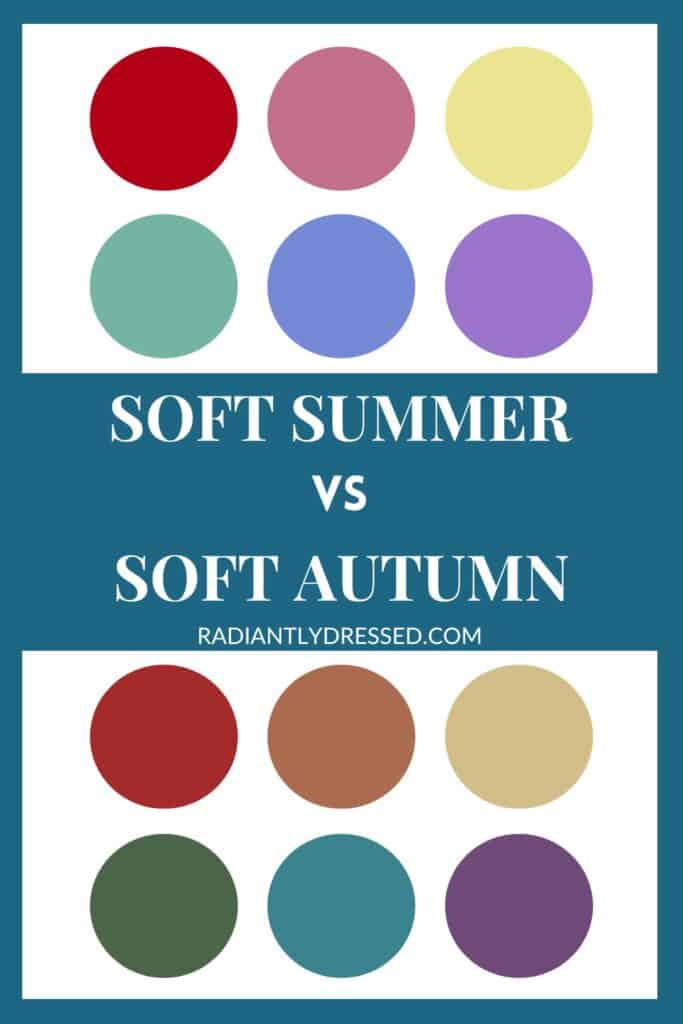
In this exploration of Soft Summer vs Soft Autumn, we delve into the nuances of each color season, offering insights on how to distinguish and embrace the palette that best complements your natural beauty.
Stacey is the owner and creator behind Radiantly Dressed. She is a certified image consultant and AICI member focusing on creating simplicity in wardrobes via color and style.

